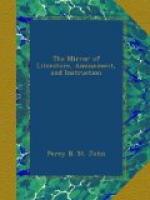The principal properties of coal-gas are here related with remarkable minuteness and precision; and as the writer exhibited them to different members of the Royal Society, and showed that after keeping the gas sometime, it still retained its elasticity and inflammability, it is remarkable, that the philosophers of the time undertook no experiments with the view of applying it to useful purposes.
Dr. John Clayton, in an extract from a letter in the “Philosophical Transactions” for 1735, calls gas the “spirit” of coal; and came to a knowledge of its inflammability by an accident. This “spirit” chanced to catch fire, by coming in contact with a candle, as it was escaping from a fracture in one of his distillatory vessels. By preserving the gas in bladders, he frequently diverted his friends, by exhibiting its inflammability. This is the nearest approach to the idea of practically applying this property.
The subject attracted the attention of Dr. Richard Watson, who published the results of his researches in the second volume of his “Chemical Essays.” He dwells upon the elasticity and inflammability of coal-gas; and remarked, that it retains these properties after passing through a great quantity of water.
The man who first applied the inflammability of gas to the purposes of illumination, was Mr. Murdoch. This gentleman, residing at Soho, near Birmingham, that hot-bed of ingenuity and mechanical science, on occasion of the celebration of the peace of 1802, covered the works of Soho with a light and splendour that astonished and delighted all the population of the surrounding country. Mr. Murdoch had not attained to this perfection without having had many difficulties to encounter. In the year 1792, he used coal gas for lighting his house and offices, at Redruth, in Cornwall; and in 1797 he again made a similar use of it at Old Cunnock, in Ayrshire. At Soho, he constructed an apparatus which enabled him to exhibit his plan on a larger scale than any he had heretofore attempted. His experiments were then seduously continued, with the able assistance of Mr. Southern and Mr. Henry Creighton, with a view to ascertain not only the best modes of making, but also of purifying and burning gas, so as to prevent either the smell or the smoke from being offensive.
Previous to the public display made of the illuminating properties of gas, at Soho, it had been applied to similar purposes, by a M. Le Bon, of Paris. A friend of the gentlemen at Soho, wrote from Paris a letter, dated November 8, 1801, to that establishment, informing them, that a person had lighted up his house and gardens with the gas obtained from wood and coal, and had it in contemplation to light up the city of Paris. This is an important fact in the detail of the history of gas-lighting; and we should be glad of further information respecting the steps which led M. Le Bon to the results which he appears to have obtained, and also respecting the fortunes which subsequently attended the invention in France. However, M. Le Bon’s exhibitions have a remarkable connexion with the progress of the invention in England: they seem, indeed, almost to have diverted it from its natural course, which certainly would have led from the illumination at Soho to its public adoption.




